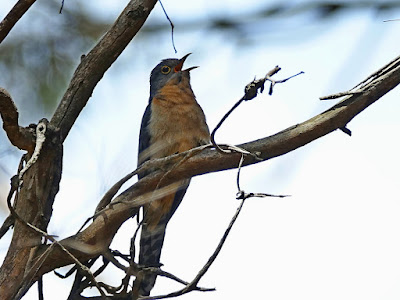The persistent, descending, plaintive trill (LINK), of the Fan-tailed Cuckoo is a common and easily recognised call in our Gippsland woodlands at this time of year.
Our Fan-tailed Cuckoos are migratory and they have been arriving for several weeks now. They come each spring from parts of northern Australia. Sometimes a few individuals might stay over winter instead of returning north.
Fan-tailed Cuckoos do the world-wide cuckoo thing; they parasitise the nests of other birds. In south-east Australia, the favoured nests seem to be the dome-shaped nests of species like Brown Thornbills, Superb Fairy-wrens and White-browed Scrubwrens but they are known to lay their eggs in the nests of more than 50 other species.
The female cuckoo lays a single egg in the chosen nest. The baby cuckoo generally hatches before the babies of the host species. The young cuckoo is ‘programmed’ to push the other eggs out of the nest. (LINK to a great You Tube video of an English Common Cuckoo chick performing this herculean feat). The parent wrens, thornbills, etc then continue to rear the young cuckoo nestling until it is ready to fledge by which time it is often many times larger than its host parents.
Fan-tailed Cuckoos feed on insects and larvae taken from the foliage and bark of trees and shrubs and directly from the ground and sometimes straight out of the air while on the wing.
The Fan-tailed Cuckoo population is regarded as secure but as the bird depends on other species to raise its young, it means that anything that impacts on numbers of species like wrens and thornbills such as climate change, urbanization, land clearing and habitat fragmentation, cuckoo numbers will be reflected in such changes.



No comments:
Post a Comment